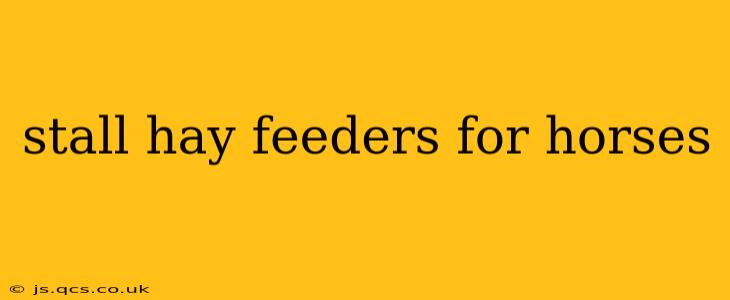Choosing the right hay feeder for your horse can significantly impact their health, behavior, and overall well-being. Slow feeding hay nets and feeders are becoming increasingly popular as they help prevent overeating, colic, and digestive issues. This comprehensive guide will explore various types of stall hay feeders, their benefits, and considerations to help you make an informed decision for your equine companion.
What are the Benefits of Using a Stall Hay Feeder?
Stall hay feeders offer numerous advantages over simply placing hay on the ground or in a bucket. These benefits include:
-
Improved Digestion: Slow feeding encourages horses to eat more naturally, mimicking their grazing patterns in the pasture. This reduces the risk of colic and other digestive problems associated with rapid consumption of large amounts of hay.
-
Reduced Waste: Feeders help contain the hay, minimizing waste and keeping your stall cleaner. This translates to cost savings on hay and less time spent cleaning.
-
Prevents Hay Spoilage: By keeping hay elevated and off the ground, you reduce exposure to moisture, dirt, and contamination, ensuring your horse consumes cleaner, fresher hay.
-
Encourages Slower Eating: The design of many feeders forces horses to eat more slowly, promoting better digestion and potentially reducing weight gain in prone horses.
-
Improved Hygiene: Keeps the hay cleaner and reduces the chances of your horse ingesting dirt or bedding.
What are the Different Types of Stall Hay Feeders?
There's a wide variety of stall hay feeders available, each with its own unique features and benefits. The best choice for you will depend on your horse's needs, your budget, and the size of your stall. Here are some popular options:
Slow Feed Hay Nets:
These are a cost-effective and readily available option. They come in various mesh sizes, allowing you to control the rate at which your horse eats. Smaller mesh sizes slow down feeding more effectively. Consider the type of hay you're feeding when selecting a mesh size; some denser hays might require a larger mesh.
Hay Bags:
Similar to slow feed nets but often sturdier and made from heavier-duty materials. Hay bags often have a larger capacity, making them ideal for horses who require larger quantities of hay.
Hay Feeders with a Slow-Feed Mechanism:
These feeders are designed to make your horse work for their food, further slowing down their consumption rate. They often have various compartments or openings that dispense hay slowly.
Elevated Hay Feeders:
These feeders lift the hay off the ground, reducing the risk of contamination and spoilage. This is beneficial for horses who tend to step on or waste their hay. They are available in various designs, including those with a wide base for stability.
What Size Hay Feeder Should I Choose?
The ideal size of your hay feeder will depend on several factors, including:
-
Your horse's size and weight: Larger horses will naturally need a larger capacity feeder.
-
The type of hay: Dense hay requires more space.
-
The feeding schedule: If you plan to refill the feeder multiple times a day, you may need a smaller feeder.
-
The amount of hay your horse needs daily: Consider the nutritional requirements of your horse and how much hay is needed to meet these needs.
How Do I Choose the Right Hay Feeder for My Horse?
Selecting the perfect stall hay feeder for your horse involves considering several key aspects. Here’s a step-by-step approach:
-
Assess your horse's needs: Does your horse have a tendency to overeat? Do they have digestive issues? Are they prone to wasting hay?
-
Consider your budget: Hay feeders range in price, from inexpensive nets to more substantial, heavy-duty models.
-
Evaluate the available space in your stall: Ensure that the feeder fits comfortably within the stall without impeding movement or creating safety hazards.
-
Choose a material that is durable and easy to clean: Look for feeders made from materials that are resistant to chewing and easy to sanitize.
-
Read reviews and compare different models: Check online reviews to see what other horse owners have to say about different hay feeder options.
Are There Any Safety Concerns to Consider with Stall Hay Feeders?
While hay feeders are generally safe, some potential concerns include:
-
Improperly secured feeders: Ensure the feeder is securely fastened to prevent tipping or toppling.
-
Entanglement hazards: Be mindful of potential hazards with hay nets or other feeders that your horse could become entangled in.
-
Choking hazards: Always supervise your horse, especially when they are first introduced to a new feeder, to ensure that they do not choke on large pieces of hay.
By carefully considering these factors, you can select a stall hay feeder that will help ensure your horse's health, well-being, and enjoyment of their mealtimes. Remember, a happy horse is a healthy horse, and providing the right equipment plays a crucial role in their overall care.
